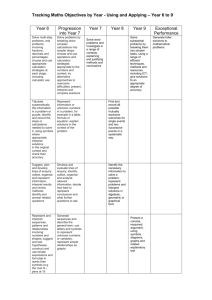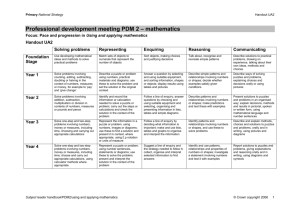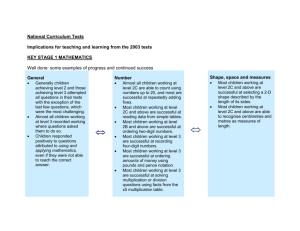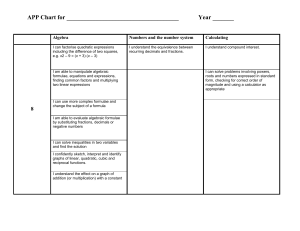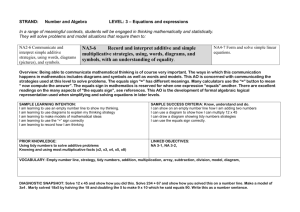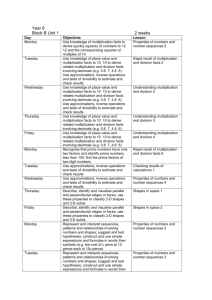Progression of Using and Applying
advertisement
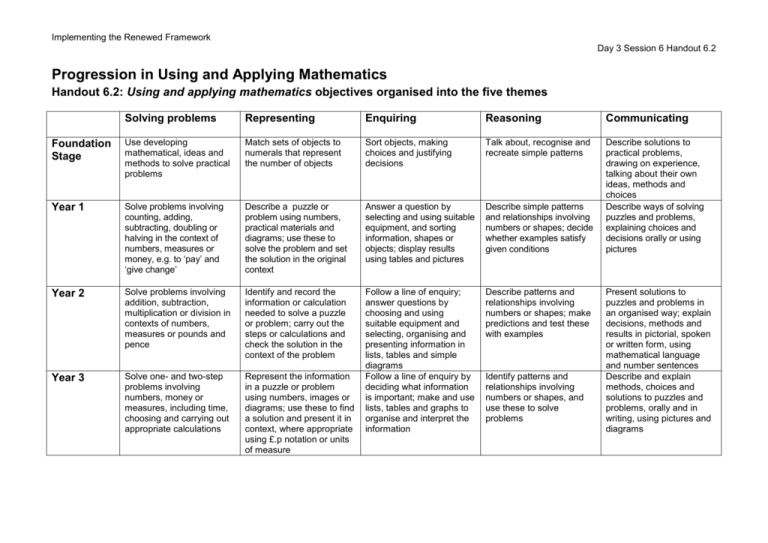
Implementing the Renewed Framework Day 3 Session 6 Handout 6.2 Progression in Using and Applying Mathematics Handout 6.2: Using and applying mathematics objectives organised into the five themes Solving problems Representing Enquiring Reasoning Communicating Foundation Stage Use developing mathematical, ideas and methods to solve practical problems Match sets of objects to numerals that represent the number of objects Sort objects, making choices and justifying decisions Talk about, recognise and recreate simple patterns Year 1 Solve problems involving counting, adding, subtracting, doubling or halving in the context of numbers, measures or money, e.g. to ‘pay’ and ‘give change’ Describe a puzzle or problem using numbers, practical materials and diagrams; use these to solve the problem and set the solution in the original context Answer a question by selecting and using suitable equipment, and sorting information, shapes or objects; display results using tables and pictures Describe simple patterns and relationships involving numbers or shapes; decide whether examples satisfy given conditions Describe solutions to practical problems, drawing on experience, talking about their own ideas, methods and choices Describe ways of solving puzzles and problems, explaining choices and decisions orally or using pictures Year 2 Solve problems involving addition, subtraction, multiplication or division in contexts of numbers, measures or pounds and pence Identify and record the information or calculation needed to solve a puzzle or problem; carry out the steps or calculations and check the solution in the context of the problem Describe patterns and relationships involving numbers or shapes; make predictions and test these with examples Year 3 Solve one- and two-step problems involving numbers, money or measures, including time, choosing and carrying out appropriate calculations Represent the information in a puzzle or problem using numbers, images or diagrams; use these to find a solution and present it in context, where appropriate using £.p notation or units of measure Follow a line of enquiry; answer questions by choosing and using suitable equipment and selecting, organising and presenting information in lists, tables and simple diagrams Follow a line of enquiry by deciding what information is important; make and use lists, tables and graphs to organise and interpret the information Identify patterns and relationships involving numbers or shapes, and use these to solve problems Present solutions to puzzles and problems in an organised way; explain decisions, methods and results in pictorial, spoken or written form, using mathematical language and number sentences Describe and explain methods, choices and solutions to puzzles and problems, orally and in writing, using pictures and diagrams Implementing the Renewed Framework Day 3 Session 6 Handout 6.2 Year 4 Year 5 Year 6 Year 6 progression to Year 7 Solve one- and two-step problems involving numbers, money or measures, including time; choose and carry out appropriate calculations, using calculator methods where appropriate Solve one- and two-step problems involving whole numbers and decimals and all four operations, choosing and using appropriate calculation strategies, including calculator use Solve multi-step problems, and problems involving fractions, decimals and percentages; choose and use appropriate calculation strategies at each stage, including calculator use Represent a puzzle or problem using number sentences, statements or diagrams; use these to solve the problem; present and interpret the solution in the context of the problem Suggest a line of enquiry and the strategy needed to follow it; collect, organise and interpret selected information to find answers Identify and use patterns, relationships and properties of numbers or shapes; investigate a statement involving numbers and test it with examples Report solutions to puzzles and problems, giving explanations and reasoning orally and in writing, using diagrams and symbols Represent a puzzle or problem by identifying and recording the information or calculations needed to solve it; find possible solutions and confirm them in the context of the problem Tabulate systematically the information in a puzzle or problem; identify and record the steps or calculations needed to solve it, using symbols where appropriate; interpret solutions in the original context and check their accuracy Plan and pursue an enquiry; present evidence by collecting, organising and interpreting information; suggest extensions to the enquiry Explain reasoning using diagrams, graphs and text; refine ways of recording using images and symbols Solve problems by breaking down complex calculations into simpler steps, choose and use operations and calculation strategies appropriate to the numbers and context; try alternative approaches to overcome difficulties; present, interpret and compare solutions Represent information or unknown numbers in a problem, e.g. in a table, formula or equation; explain solutions in the context of the problem Develop and evaluate lines of enquiry; identify, collect, organise and analyse relevant information; decide how best to represent conclusions and what further questions to ask Explore patterns, properties and relationships, and propose a general statement involving numbers or shapes; identify examples for which the statement is true or false Represent and interpret sequences, patterns and relationships involving numbers and shapes; suggest and test hypotheses; construct and use simple expressions and formulae in words then symbols, e.g. the cost of c pens at 15 pence each is 15c pence Generate sequences and describe the general term; use letters and symbols to represent unknown numbers or variables; represent simple relationships as graphs Suggest, plan and develop lines of enquiry; collect, organise and represent information, interpret results and review methods; identify and answer related questions Explain reasoning and conclusions, using words, symbols or diagrams as appropriate Explain and justify reasoning and conclusions, using notation, symbols and diagrams; find a counterexample to disprove a conjecture; use step-bystep deductions to solve problems involving shapes
